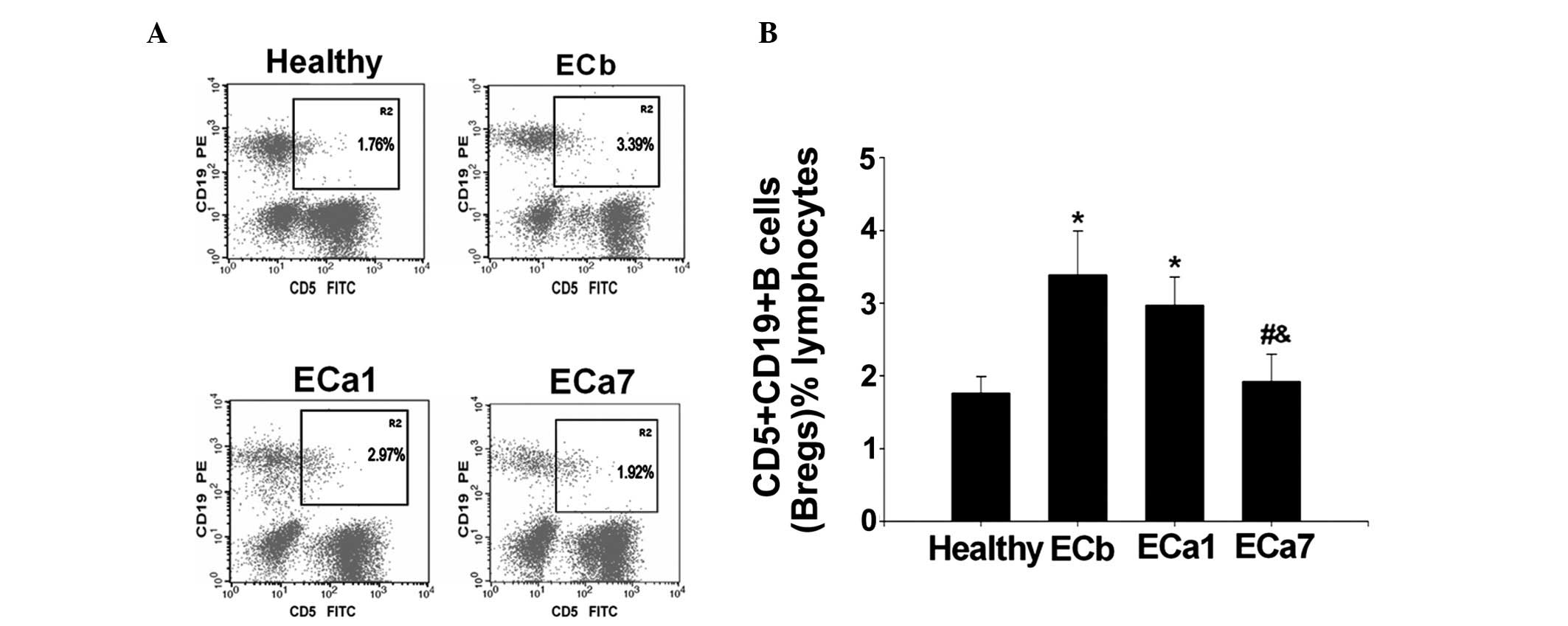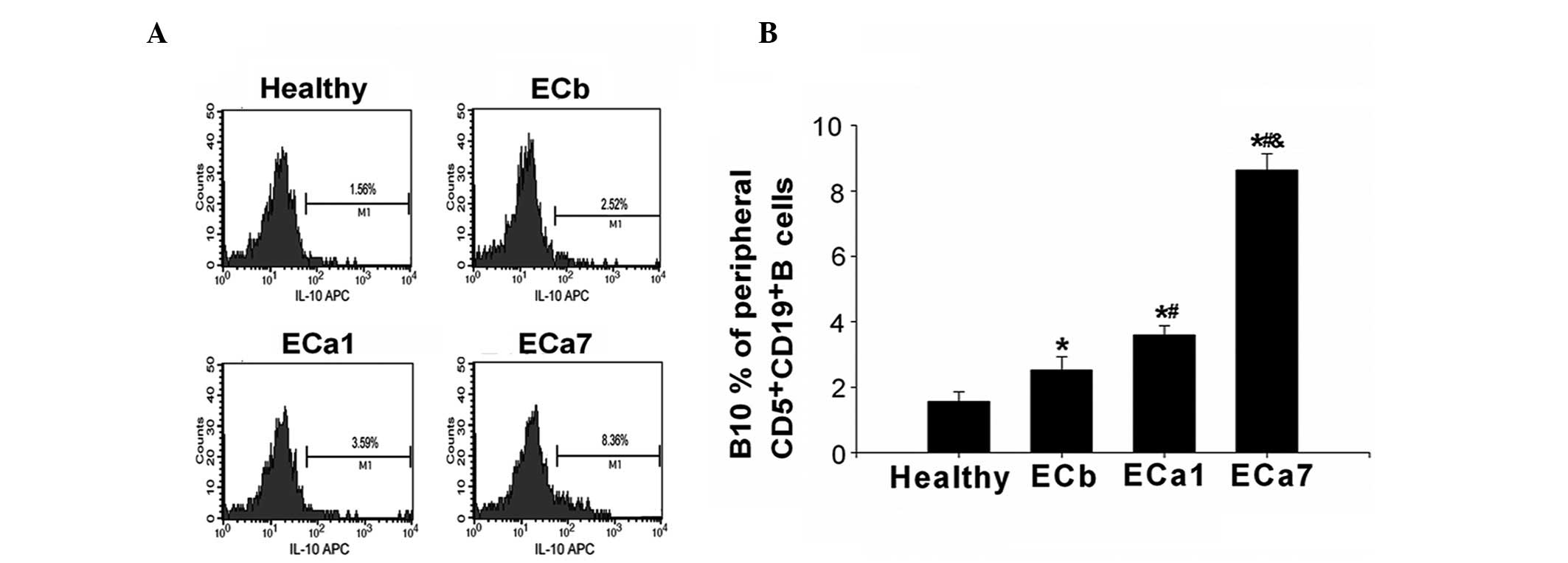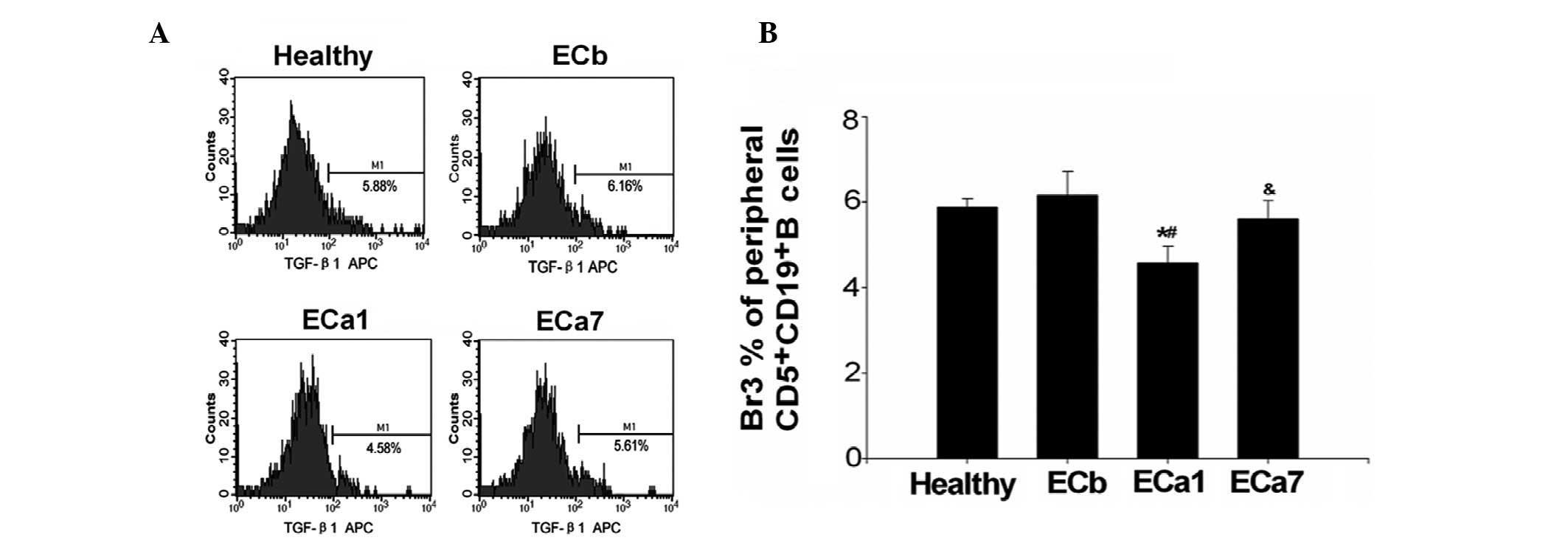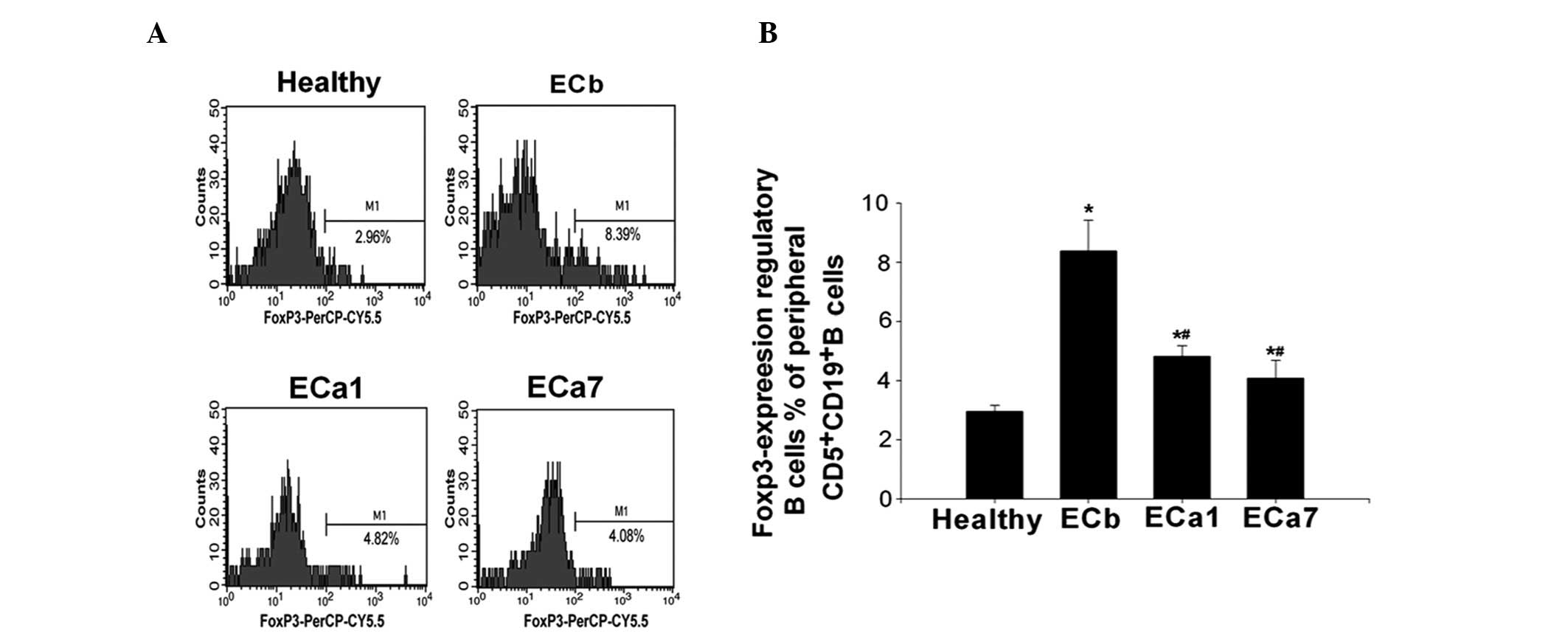Perioperative changes in peripheral regulatory B cells of patients with esophageal cancer
- Authors:
- Published online on: June 19, 2014 https://doi.org/10.3892/mmr.2014.2347
- Pages: 1525-1530
Abstract
Introduction
Esophageal cancer (EC), the eighth leading cause of cancer-related mortality globally, has a poor prognosis among digestive tract malignancies and an annual diagnosis of approximately half a million individuals worldwide (1,2). The incidence of EC has markedly increased over the past three decades (3). A total of 482,000 new EC cases are diagnosed annually worldwide, resulting in 407,000 mortalities (2). Surgery and radiotherapy are limited to treating local tumors, whereas chemotherapy is limited by toxicity due to its low tumor specificity (1). Considerable evidence suggests that the immune system recognizes and destroys tumor cells, particularly EC cells (4–7).
B cells perform several immunological functions and have been identified to be positive regulators of immune responses and central contributors to the pathogenesis of immune-related diseases as a result of their capacity to produce antigen-specific antibodies (8). However, over the past 30 years, evidence has supported a negative regulatory function for B cells (8,9). Advances in B-cell biology have demonstrated that regulatory B cells (Bregs) release numerous cytokines, with certain Bregs involved in the production of negative regulatory cytokines, including interleukin (IL)-10 (B10s) and transforming growth factor-β (TGF-β) (Br3s), and others expressing the transcription factor forkhead box protein 3 (Foxp3) (10). Previous studies have demonstrated that Bregs have a significant role in the development and resolution of numerous chronic diseases, including experimental autoimmune encephalomyelitis, inflammatory bowel disease and contact hypersensitivity (11–13). The regulatory mechanisms associated with Bregs in the immune system include protection from lethal inflammation, modulation of the development of autoimmune diseases (13–15) and inhibition of anti-tumor responses in various tumor models (16–19). However, few studies have assessed the role of Bregs in EC development.
While evidence has indicated the importance of Bregs in tumor development, there has, to the best of our knowledge, been no research into the functions of Bregs in cancer, particularly in patients with EC (20). The present study investigated the perioperative changes in the Bregs in patients with EC and the association between these cells and clinical phenotypes.
Material and methods
Patient selection
A total of 60 patients with EC were recruited into this case-control study, including 36 males and 24 females with an age range of 50–70 years and a mean age of 64 years. Patients with EC were recruited from the Department of Cardiothoracic Surgery, Lianyungang Hospital Affiliated to Bengbu Medical College (Lianyungang, China). All cases of EC had been histologically confirmed prior to the study. None of the patients with EC had received any invasive treatment, such as radiotherapy or neoadjuvant chemotherapy, prior to tumor resection. Patients with EC were analyzed using the seventh edition of the American Joint Committee on Cancer tumor, node and metastasis staging system in EC for the assessment of disease severity (21). Age- and gender-matched healthy controls were recruited from the Medical Examination Centre of Lianyungang Hospital Affiliated to Bengbu Medical College between July 2011 and July 2012. None of the subjects had a history of autoimmune diseases or tumors.
This study was approved by the Ethical Committee of Lianyungang Hospital Affiliated to Bengbu Medical College (no. 2011-108) and was conducted in compliance with the Declaration of Helsinki. All participants were informed about the investigative nature of the study and signed an informed consent document prior to enrollment in the study.
Sample collection and preparation
Peripheral blood samples were obtained from venous blood immediately subsequent to admission but prior to treatment intervention, in addition to at one and seven days after tumor resection. Peripheral blood mononuclear cells (PBMCs) were isolated from the peripheral blood samples using density gradient separation. Whole blood samples were overlaid onto Ficoll® separation media (GE Healthcare, Waukesha, WI, USA) following 1:1 dilution with Hank’s Balanced Salt Solution (Gibco-BRL, Carlsbad, CA, USA). PBMCs were then centrifuged at 1,500 × g for 30 min, collected at the plasma interface and washed three times following centrifugation at 1,500 × g for 10 min.
The isolated PBMCs were resuspended in a complete RPMI-1640 GlutaMax™ medium (Gibco-Invitrogen, Breda, The Netherlands) at 5×106 cells/ml in two Falcon™ tubes. GolgiPlug™ (BD Biosciences, San Jose, CA, USA) was then added to each tube and cells were incubated for 5 h in 5% CO2 at 37°C. Following incubation, PBMCs were stained for 15 min in the dark using phycoerythrin-labeled anti-cluster of differentiation (CD) 19 and fluorescein isothiocyanate-labeled anti-CD5 (BD Biosciences) monoclonal antibodies. PBMCs were then permeabilized/fixed using the FIX&PERM® kit (ADG, Kaumberg, Austria). Cells were successively stained for 15 min in the dark using allophycocyanin-labeled anti-IL-10 and -TGF-β1 monoclonal antibodies and peridinin chlorophyll-cyanine5.5-labeled anti-FOXP3 monoclonal antibodies (BD Biosciences), prior to washing once with phosphate-buffered saline (PBS). Cells were resuspended in 500 μl PBS prior to flow cytometric analysis.
Flow cytometry
Flow cytometric analysis was conducted using a BD FACSCalibur flow cytometer (BD Biosciences). For the analysis of Bregs, the acquisition and analysis gates were restricted to the live lymphocyte population. For myeloid-derived suppressor cell analysis, all live cells were included. CD5+CD19+ cells were calculated as the percentage of live CD19+ lymphocytes. Bregs were identified as CD5+CD19+ cells and the production of IL-10, FOXP3 and TGFβ1 was calculated as the percentage of cytokines.
Statistical analysis
All values are presented as the mean ± standard error of the mean. Statistical analyses were performed using SPSS 11.0 statistical software (SPSS Inc., Chicago, IL, USA). The percentage of Bregs among the groups was analyzed using one-way analysis of variance, followed by an unpaired student’s t-test. A value of P<0.05 was considered to indicate a statistically significant difference.
Results
Perioperative changes in peripheral Bregs
As shown in Fig. 1, the percentage of peripheral Bregs in patients with EC prior to surgery (ECb) was observed to be significantly higher than that in the group of healthy controls (3.40±0.60 vs. 1.76±0.23%; P<0.05). No significant difference was observed in the percentage of Bregs between patients with EC at one day after surgery (ECa1) and the ECb group (2.99±0.39 vs. 3.40±0.60%; P>0. 05; Fig. 1). However, a significant reduction in the percentage of Bregs was observed in patients with EC at seven days after tumor resection (ECa7) compared with the ECb (1.92±0.39 vs. 3.40±0.60%; P<0.05; Fig. 1) and ECa1 (1.92±0.39 vs. 2.99±0.39%; P<0.05; Fig. 1) groups.
Perioperative changes in peripheral B10s
As shown in Fig. 2, the percentage of B10s in the ECb group was observed to be significantly higher than that in the healthy controls (2.52±0.41 vs. 1.56±0.28%; P<0.05). Furthermore, the percentage of B10s in the patients with EC significantly increased over time following tumor resection (3.59±0.29% in ECa1 vs. 8.36±0.51% in ECa7; P<0.05).
Perioperative changes in peripheral Br3s
The percentage of Br3s in the ECb group was not observed to be significantly different from that of the healthy controls (6.13±0. 57 vs. 5.91±0.23%; P>0.05; Fig. 3). However, the percentage of Br3s was observed to decrease in the ECa1 group compared with the ECb group (4.54±0.41 vs. 6.13±0. 57%) prior to increasing in the ECa7 group (5.61±0.42%). The percentage of Br3s in the ECa7 group remained below that in the ECb group, although the difference was not significant (P>0.05) (Fig. 3).
Perioperative changes in peripheral Foxp3-expressing Bregs
As shown in Fig. 4, the percentage of Foxp3-expressing Bregs was observed to be significantly higher in the ECb group than that in the healthy controls (8.35±1.04 vs. 2.91±0.23%; P<0.05). However, the percentage of Foxp3-expressing Bregs was shown to significantly decrease over time following tumor resection (8.35±1.04 in ECb vs. 4.84±0.16 in ECa1 and 4.02±0.66% in ECa7; P<0.05). The frequency of Foxp3-expressing Bregs was observed to be lower in the ECa7 group compared with that in the ECa1 group; however, this difference was not significant (4.84±0.16 vs. 4.02±0.66%; P>0.05) (Fig. 4).
Discussion
As a functionally unique subgroup of B lymphocytes, Bregs promote tumor progression in various malignancies, including sarcomas, melanomas, breast carcinomas and hepatocellular carcinomas (5,22,23). However, current studies on Bregs have been predominantly conducted using animal models. Thus, the disease-specific patterns of peripheral Bregs in patients with EC are yet to be elucidated. The present study investigated the functions of CD5+CD19+ B-cell-derived IL-10, TGF-β and FOXP3 in patients with EC.
IL-10 is a 178-amino acid protein secreted by various cells, primarily Type 2 helper T-cell (Th2) clones (24). IL-10 has multiple functions in immune modulation and exhibits anti-inflammatory and suppressive effects on hematopoietic cells (17). A number of studies have identified IL-10-producing CD19+ B cells, which are known as B10s (8,10,12). Lee et al (25,26) described human IL-10-producing Bregs that expressed a CD5+CD19+ phenotype in PBMCs. The present study demonstrated that the percentage of B10s was higher in patients with EC than that in healthy controls and was markedly increased following surgery, with the in the ECa7 group exceeding that in the ECa1 group. These findings are consistent with the significant perioperative changes observed in peripheral Bregs in patients with hepatocellular carcinoma reported by Chen et al (23).
TGF-β belongs to a superfamily of cytokines that regulates cell proliferation and differentiation, developmental patterning and morphogenesis, and disease pathogenesis (24). TGF-β1 plays critical roles in tumor development through its influence on the apoptotic pathways (27–29). Miller et al (30) demonstrated that TGF-β1 is crucial in the progression of EC due to the fact that it induces the activation of extracellular signal-regulated protein kinases 1 and 2. In a study by Tian et al (31), an additional Breg subgroup, which produced TGF-β1 following in vitro stimulation with lipopolysaccharides, was identified. Furthermore, Lee et al (32) recently reported the presence of Br3s in human peripheral blood. The present study revealed that the percentage of peripheral Br3s was higher in patients with EC than that in healthy controls. In addition, the percentage of Br3s was observed to markedly increase following surgery in patients with EC. Therefore, the systemic inflammatory state induced by EC cells may promote peripheral Br3 production.
Foxp3 is a transcription factor that controls the development of regulatory T cells and is reported to be expressed in mouse CD4+ T cells (33). CD4+Foxp3+ T cells are known as Tregs and are involved in the negative regulation of immune responses (33). A study by Huang and Fu (7) reported that CD4+Foxp3+ T cells are present in EC tissues at levels 10-fold higher than those in non-EC tissues. Furthermore, Wang et al (34) demonstrated that FOXP3 is overexpressed in EC cells, but not found in normal esophageal mucosal cells. A study has also indicated that CD5+CD19+Foxp3+ Bregs are present among human PBMCs (35). The results of the present study demonstrate that the percentage of peripheral CD5+CD19+Foxp3+ Bregs is higher in patients with EC than that in healthy controls. Furthermore, the percentage of CD5+CD19+Foxp3+ Bregs was observed to significantly decrease in patients with EC following surgery. However, the percentage of these cells in the peripheral blood of the ECa7 group was not observed to differ significantly from that of the ECa1 group. These results suggest that FOXP3 overexpression may be significantly correlated with tumor staging and lymph node metastasis.
To the best of our knowledge, the present study is the first to demonstrate the perioperative changes in circulating Bregs in patients with EC prior to and following radical surgery. Further studies are required to determine whether the increases in circulating Bregs following surgery are a consequence of the tumor removal or of the extensive esophageal surgery. The mediators of Br1, Br3 and Bregs should be profiled and validated in order to elucidate the mechanisms associated with their interactions. Network biomarkers that show protein-protein interactions within these regulatory cells should be investigated based on protein annotations, interactions and signaling pathways (36,37).
In conclusion, the current study demonstrated that the percentage of peripheral Br3s and Foxp3-expressing Bregs decreased following surgery in patients with EC, whereas the percentage of circulating B10s was significantly increased in patients with advanced EC following surgery. Furthermore, Foxp3 and TGF-β may be involved in regulating the number and function of Bregs in patients with advanced EC who undergo surgery. The findings of the present study suggest that, in patients with EC, the level of IL-10 reduced to the levels of healthy controls via medical intervention, therefore this may confer an enhanced prognosis following surgery.
Acknowledgements
This study was supported by a grant from the Department of Science & Technology, Lianyungang, Jiangsu, P.R. China (no. SH1008).
Abbreviations:
|
EC |
esophageal cancer |
|
Bregs |
regulatory B cells |
|
Foxp3 |
forkhead/winged-helix protein |
|
TGF-β |
transforming growth factor-β |
|
IL-10 |
interleukin-10 |
|
B10 |
IL-10-producing regulatory B cell |
|
Br3 |
TGF-β-producing regulatory B cells |
References
|
Kamangar F, Dores GM and Andeson WF: Patterns of cancer incidence, mortality, and prevalence across five continents: defining priorities to reduce cancer disparities in different geographic regions of the world. J Clin Oncol. 24:2137–2150. 2006. View Article : Google Scholar | |
|
Ferlay J, Shin HR, Bray F, Forman D, Mathers C and Parkin DM: Estimates of worldwide burden of cancer in 2008: GLOBOCAN 2008. Int J Cancer. 127:2893–2917. 2010. View Article : Google Scholar : PubMed/NCBI | |
|
Enzinger PC and Mayer RJ: Esophageal Cancer. N Engl J Med. 349:2241–2252. 2003. View Article : Google Scholar : PubMed/NCBI | |
|
Watanabe R, Ishiura N, Nakashima H, Kuwano Y, Okochi H, Tamaki K, Sato S, Tedder TF and Fujimoto M: Regulatory B cells (B10 cells) have a suppressive role in murine lupus: CD19 and B10 cell deficiency exacerbates systemic autoimmunity. J Immunol. 184:4801–4809. 2010. View Article : Google Scholar | |
|
Olkhanud PB, Damdinsuren B, Bodogai M, Gress RE, Sen R, Wejksza K, Malchinkhuu E, Wersto RP and Biragyn A: Tumor-evoked regulatory B cells promote breast cancer metastasis by converting resting CD4+ T cells to T-regulatory cells. Cancer Res. 71:3505–3515. 2011. View Article : Google Scholar : PubMed/NCBI | |
|
Schioppa T, Moore R, Thompson RG, Rosser EC, Kulbe H, Nedospasov S, Mauri C, Coussens LM and Balkwill FR: B regulatory cells and the tumor promoting actions of TNF-α during squamous carcinogenesis. Proc Natl Acad Sci USA. 108:10662–10667. 2011.PubMed/NCBI | |
|
Huang C and Fu ZX: Localization of IL-17+Foxp3+ T cells in esophageal cancer. Immunol Invest. 40:400–412. 2011. | |
|
Mauri C and Bosma A: Immune regulatory function of B cells. Annu Rev Immunol. 30:221–241. 2012. View Article : Google Scholar : PubMed/NCBI | |
|
Lund FE and Randall TD: Effector and regulatory B cells: modulators of CD4+ T cell immunity. Nat Rev Immunol. 10:236–247. 2010. View Article : Google Scholar : PubMed/NCBI | |
|
Noh G and Lee JH: Regulatory B cells and allergic diseases. Allergy Asthma Immunol Res. 3:168–177. 2011. View Article : Google Scholar : PubMed/NCBI | |
|
Watanabe R, Fujimoto M, Ishiura N, Kuwano Y, Nakashima H, Yazawa N, Okochi H, Sato S, Tedder TF and Tamaki K: CD19 expression in B cells is important for suppression of contact hypersensitivity. Am J Pathol. 171:560–570. 2007. View Article : Google Scholar : PubMed/NCBI | |
|
Yanaba K, Bouaziz JD, Haas KM, Poe JC, Fujimoto M and Tedder TF: A regulatory B cell subset with a unique CD1dhiCD5+ phenotype controls T cell-dependent inflammatory responses. Immunity. 28:639–650. 2008. View Article : Google Scholar : PubMed/NCBI | |
|
Matsushita T, Yanaba K, Bouaziz JD, Fujimoto M and Tedder TF: Regulatory B cells inhibit EAE initiation in mice while other B cells promote disease progression. J Clin Invest. 118:3420–3430. 2008.PubMed/NCBI | |
|
Fillatreau S, Sweenie CH, McGeachy MJ, Gray D and Anderton SM: B cells regulate autoimmunity by provision of IL-10. Nat Immunol. 3:944–950. 2002. View Article : Google Scholar : PubMed/NCBI | |
|
Mizoguchi A, Mizoguchi E, Takedatsu H, Blumberg RS and Bhan AK: Chronic intestinal inflammatory condition generates IL-10-producing regulatory B cell subset characterized by CD1d upregulation. Immunity. 16:219–230. 2002. View Article : Google Scholar : PubMed/NCBI | |
|
Fillatreau S, Gray D and Anderton SM: Not always the bad guys: B cells as regulators of autoimmune pathology. Nat Rev Immunol. 8:391–397. 2008. View Article : Google Scholar : PubMed/NCBI | |
|
DiLillo DJ, Matsushita T and Tedder TF: B10 cells and regulatory B cells balance immune responses during inflammation, autoimmunity, and cancer. Ann NY Acad Sci. 1183:38–57. 2010. View Article : Google Scholar : PubMed/NCBI | |
|
Mauri C and Ehrenstein MR: The ‘short’ history of regulatory B cells. Trends Immunol. 29:34–40. 2008. | |
|
Mizoguchi A and Bhan AK: A case for regulatory B cells. J Immunol. 176:705–710. 2006. View Article : Google Scholar | |
|
Mosser D and Zhang X: Interleukin-10: new perspectives on an old cytokine. Immunol Rev. 226:205–218. 2008. View Article : Google Scholar : PubMed/NCBI | |
|
Edge S, Byrd DR, Compton CC, Fritz AG, Greene FL and Trotti A: AJCC Cancer Staging Manual. Seventh edition. Springer; New York, NY: 2010 | |
|
Inoue S, Leitner WW, Golding B and Scott D: Inhibitory effects of B cells on antitumor immunity. Cancer Res. 66:7741–7747. 2006. View Article : Google Scholar : PubMed/NCBI | |
|
Chen T, Song D, Min Z, et al: Perioperative dynamic alterations in peripheral regulatory T and B cells in patients with hepatocellular carcinoma. J Transl Med. 10:142012. View Article : Google Scholar : PubMed/NCBI | |
|
Im SH, Hueber A, Monticelli S, Kang KH and Rao A: Chromatin-level regulation of the IL10 gene in T cells. J Biol Chem. 279:46818–46825. 2004. View Article : Google Scholar : PubMed/NCBI | |
|
Lee JH, Noh J, Noh G, Choi WS and Lee SS: IL-10 is predominantly produced by the CD19(low)CD5(+) regulatory B cell subpopulation: characterization of CD19(high) and CD19(low) subpopulations of CD5(+) B cells. Yonsei Med J. 52:851–855. 2011. View Article : Google Scholar : PubMed/NCBI | |
|
Lee JH, Noh J, Noh G, Kim HS, Mun SH, Choi WS, Cho S and Lee S: Allergen-specific B cell subset responses in cow’s milk allergy of late eczematous reactions in atopic dermatitis. Cell Immunol. 262:44–51. 2010. | |
|
Itoh S and Itoh F: Implication of TGF-β as a survival factor during tumour development. J Biochem. 151:559–562. 2012. | |
|
Hoshino Y, Katsuno Y, Ehata S and Miyazono K: Autocrine TGF-β protects breast cancer cells from apoptosis through reduction of BH3-only protein, Bim. J Biochem. 149:55–65. 2011. | |
|
Edlund S, Bu S, Schuster N, Aspenström P, Heuchel R, Heldin NE, ten Dijke P, Heldin CH and Landström M: Transforming growth factor-beta1 (TGF-beta)-induced apoptosis of prostate cancer cells involves Smad7-dependent activation of p38 by TGF-beta-activated kinase 1 and mitogen-activated protein kinase kinase 3. Mol Biol Cell. 14:529–544. 2003. View Article : Google Scholar | |
|
Miller AV, Alvarez SE, Spiegel S and Lebman DA: Sphingosine kinases and sphingosine-1-phosphate are critical for transforming growth factor beta-induced extracellular signal-regulated kinase 1 and 2 activation and promotion of migration and invasion of esophageal cancer cells. Mol Cell Biol. 28:4142–4151. 2008. View Article : Google Scholar | |
|
Tian J, Zekzer D, Hanssen L, Lu Y, Olcott A and Kaufman DL: Lipopolysaccharide-activated B cells down-regulate Th1 immunity and prevent autoimmune diabetes in nonobese diabetic mice. J Immunol. 167:1081–1089. 2001. View Article : Google Scholar : PubMed/NCBI | |
|
Lee JH, Noh J, Noh G, Choi WS, Cho S and Lee SS: Allergen-specific transforming growth factor-β-producing CD19+CD5+ regulatory B-cell (Br3) responses in human late eczematous allergic reactions to cow’s milk. J Interferon Cytokine Res. 31:441–449. 2011. | |
|
Hori S, Nomura T and Sakaguchi S: Control of regulatory T cell development by the transcription factor Foxp3. Science. 299:1057–1061. 2003. View Article : Google Scholar : PubMed/NCBI | |
|
Wang G, Liu G, Liu Y, Li X and Su Z: FOXP3 Expression in esophageal cancer cells is associated with poor prognosis in esophageal cancer. Hepatogastroenterology. 59:2186–2191. 2012.PubMed/NCBI | |
|
Noh J, Choi WS, Noh G and Lee JH: Presence of Foxp3-expressing CD19(+)CD5(+) B Cells in human peripheral blood mononuclear cells: Human CD19(+)CD5(+)Foxp3(+) regulatory B cell (Breg). Immune Netw. 10:247–249. 2010. View Article : Google Scholar : PubMed/NCBI | |
|
Baumgartner C, Osl M, Netzer M and Baumgartner D: Bioinformatic-driven search for metabolic biomarkers in disease. J Clin Bioinforma. 1:22011. View Article : Google Scholar : PubMed/NCBI | |
|
Wang X and Liotta L: Clinical bioinformatics: a new emerging science. J Clin Bioinforma. 1:12011. View Article : Google Scholar : PubMed/NCBI |













